Better Tools for Remediation Projects
When looking for a GHG reporting program, there is one element that is typically overlooked. This short video gives us more insight.
When looking for a GHG reporting program, there is one element that is typically overlooked. This short video gives us more insight.
Scientific calculations are an essential aspect of many fields of study, including physics, chemistry, and engineering including environmental engineering. These calculations involve complex formulas and equations that are often too time-consuming and challenging to solve by hand. Fortunately, programming languages and software have made it easier for scientists and researchers to carry out scientific calculations quickly and accurately. Software plays a vital role in environmental calculations, as it provides scientists and researchers with a powerful tool for analyzing and interpreting complex data related to the environment. Environmental engineers need to deal with vast amounts of data that must be analyzed to draw meaningful conclusions. The environmental field encompasses a wide range of disciplines, including climate science, ecology, and environmental engineering, and each of these areas requires specific types of calculations that can be performed more efficiently and accurately using computers.
In recent years, many programming languages have been developed that are specifically designed for scientific computing. These languages, such as MATLAB, Python, and R, are powerful tools for numerical analysis and data visualization. However, programming for environmental calculations poses some challenges. One of the primary challenges is ensuring that the code is accurate and reliable. Even small errors in the code can lead to significant errors in the results, which can have serious consequences for environmental decision-making.
Collections of environmental data in an enterprise pose another set of challenges, including gathering data from all business units and ensuring the accuracy, accessibility, interoperability, and privacy of data. Addressing these challenges requires careful planning, collaboration, and the adoption of standardized data formats and protocols.
Software applications developed at Locus like Environmental Information Management (EIM), Greenhouse Gas, Air Emissions and Sustainability address these challenges by offering tailored solutions for environmental scientists. One of the key advantages of using these applications is that it allows scientists to automate many of the tedious and time-consuming tasks involved in data collection, scientific calculations, analysis, and regulatory reporting. These applications have gone through extensive testing ensuring accurate and reliable results and the automation can make regulatory reporting a breeze when time is of the essence.
In conclusion, scientific calculations are an essential aspect of environmental engineering, and Locus offers powerful tools for performing these calculations quickly and accurately. By using Locus software, scientists and researchers can automate tedious tasks, process large datasets, and extract valuable insights from the environmental data of the organization.
When looking for a GHG reporting program, there is one element that is typically overlooked. This short video gives us more insight.
Locus’ Air Quality app is designed to integrate with data sources to seamlessly calculate air emissions monthly or annually.
Simplify your air quality data management and reporting with Locus’ unified software solution. Our Air Quality application resolves most common issues with managing and submitting your site emissions data.
Time management is an ever-present struggle. With expanding air quality monitoring and regulatory programs, more is expected from air quality professionals without compromising work quality. Locus Technologies offers the tools to ease your workload. Here’s how Locus transforms your air quality data and reporting management:
Integration can save you a great deal of time and stress with the most cumbersome air quality data management duties. Our air quality software has a unique point and click integration application enabling connection with major databases and third-party systems that have open API (access privileges). Some integration, database, and communication standards and methods that are supported include OLE compliance, SOAP, COM, Java, XML, web services, DBC/ODMA/SQL/Oracle, AWS, VIM, and MAPI.
Locus also provides a powerful two-way synchronization with MS Excel, allowing users to download to Excel, then work, edit, verify, or append data on their local copy of Excel. Any revisions they perform to the downloaded data can be automatically synchronized back to the Locus Platform application. During the process, a complete audit trail will be preserved. This is a great time saver, especially if you are sending large volumes of valid values in a database or if you are migrating any historical data.
Your air quality data management software should have built-in dashboards to meet your needs. With other software providers, when you need a new report, chart, or other visualization of your air quality data, it usually incurs a custom software development charge. Locus allows you to assemble the information you want in your chosen format (bar or line charts, maps, tables, treemaps, diagrams, etc.) and share your custom dashboards and real-time information/data with your team or regulators without the fees. In addition, the views and dashboards export to Excel, so you can easily integrate with commonly used tools and further mine the data.
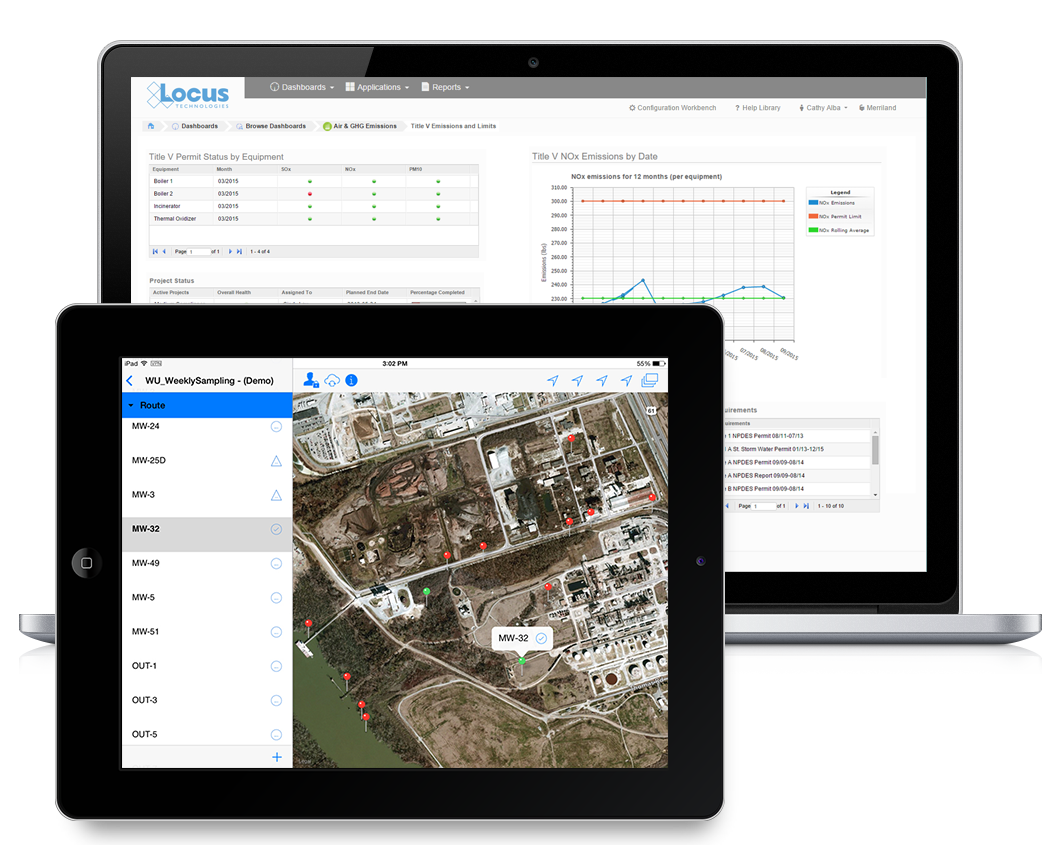
With Locus, powerful dashboards will help you understand the status of single of multiple facilities in an air quality program based on a matrix you design. With the the flexibility of Locus, facility information can be automatically populated based on the user credentials, saving you and your team time and frustration.
Locus Platform’s air quality application and calculation engine supports simultaneous calculations using multiple methods for various reporting programs including EPA, State, or Local, CDP, TCR, DJSI, Title V, e, and others. Our software also assists in streamlining your emissions tracking and reporting requirements for programs such as GHG, Fenceline, Title V, and LCFS. Locus air quality software is fully integrated with our compliance/asset management and remote sensing systems, making digital transformation more efficient. In addition, Locus’ vapor intrusion and indoor air management application will easily organize, manage, and report indoor air and vapor intrusion data.
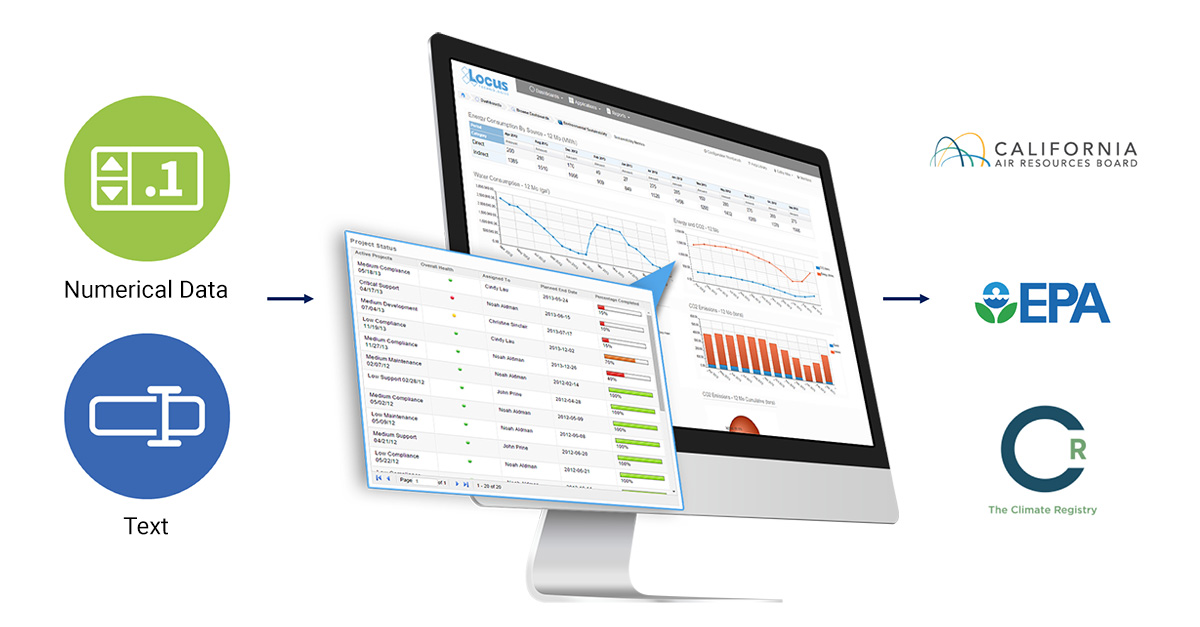
This allows users to input data only once and utilize it to report to multiple federal, state, and voluntary reporting programs, according to your required format. The application will also support direct electronic reporting formats for many reporting programs, so that additional manual transcription and submittal of data are no longer necessary. This is a very powerful tool and a huge advantage to customers in terms of improving efficiency, while reducing costs.
Locus’ Mobile application allows you to sync with your server to create in-field data collection profiles on a mobile device, whether it’s your phone or a tablet. It will allow you to click through and enter field inspection data on the device even when you are offline. Air quality field operations data validation is performed in real-time and is stored locally on the device when you are out of service range, with data will automatically being updated in Locus’ cloud when you have connection.
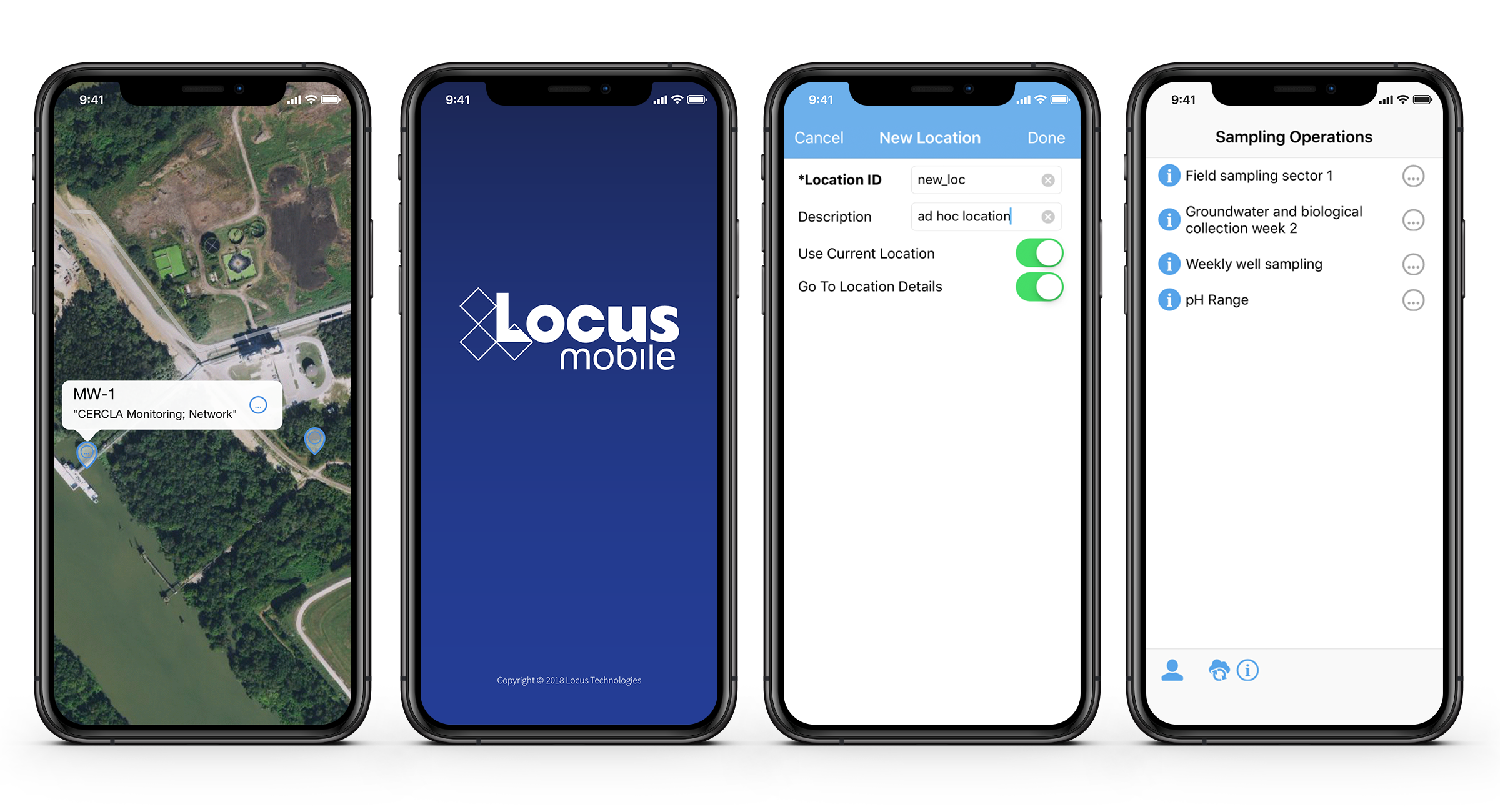
Locus gives the benefits of data entry directly on the mobile device, with immediate data availability on the cloud when you reach an internet signal. Other advantages of using Locus Mobile includes location metadata and mapping integration, bar-code/OR code scanning, voice recognition, and form customization.
To alleviate the effort in researching complex air emissions calculations ranging from GHG to Tank emissions, Locus has designed a Java Library, Curta, for complicated scientific computing on our software. Curta contains a collection of built-in functionality, unit conversions, periodic and hierarchical calculations that can be used to solve mathematical models of problems in Science and Engineering.
Curta can be used directly as API (Application Program Interface) in the UI (User Interface) design, or implicitly combined with the Locus Platform Sustainability application with clear break down into calculation indicators and sources. It offers an integrated solution to work with different data types, continuously changing inputs and large set of unknown variables.
Curta features include:
Locus recently joined the nuclear power plant community in Orlando, FL for this year’s Radiological Effluents and Environmental Workshop. It’s always a pleasure to join other professionals in a space that encourages discussion, education, and awareness of industry processes and compliance.
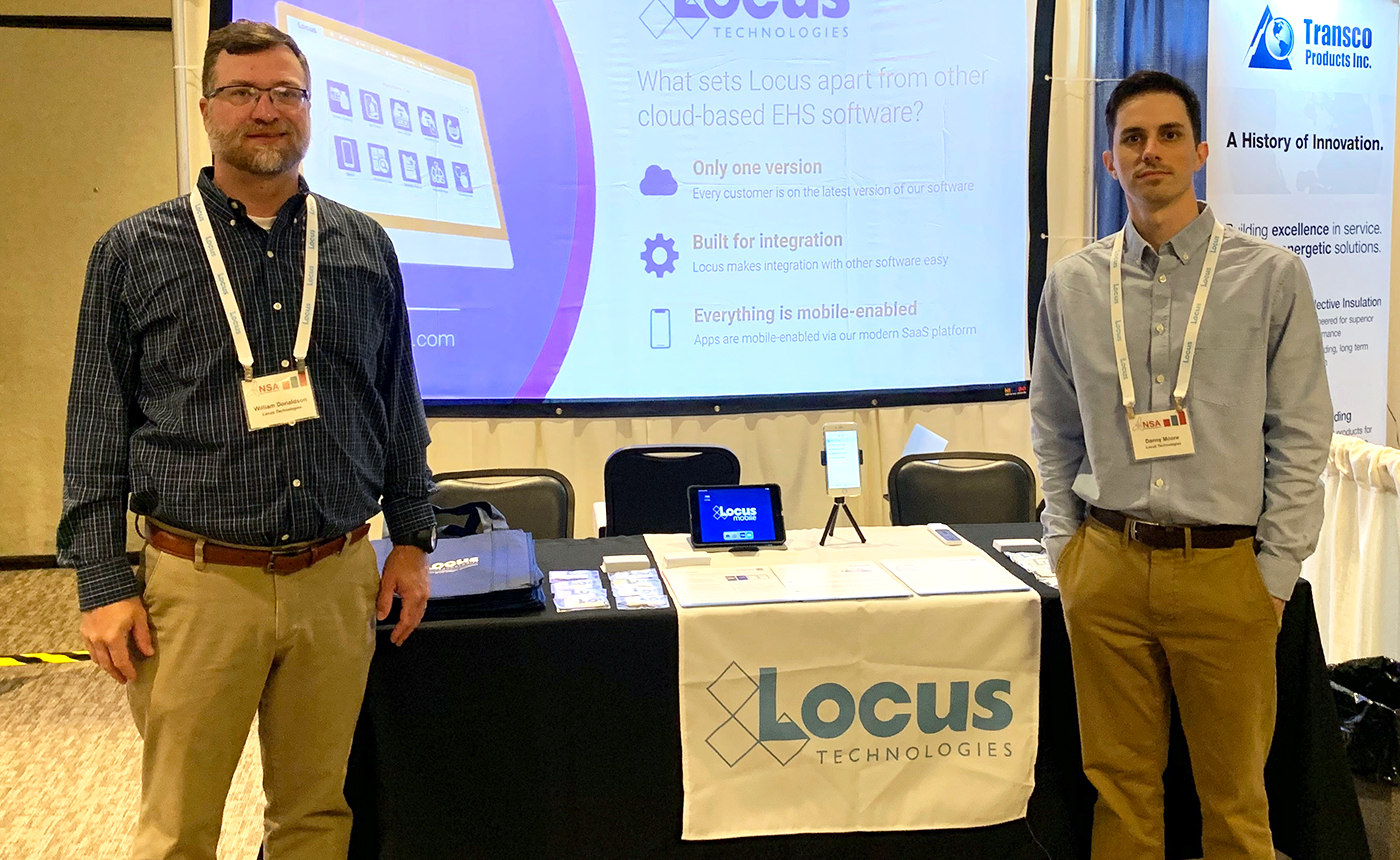
Bill Donaldson and Danny Moore of Locus Technologies.
Each conference we attend is an opportunity to learn. Whether talking with current or potential customers, it’s always fascinating to hear some of the success and horror stories experienced in their daily operations. We’ve summarized a few of those conversations below. And since REEW takes place in the summer, there’s a theme.
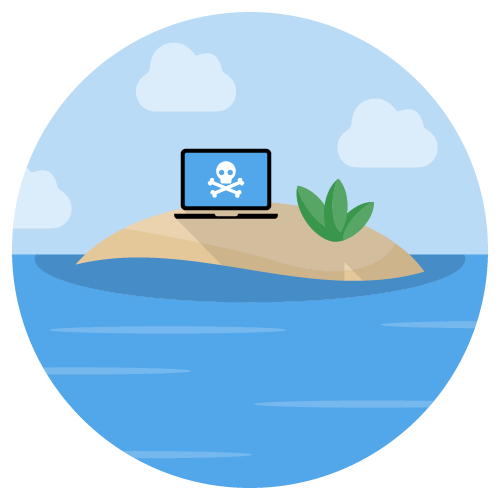 Version Island
Version IslandImagine you’ve spent years utilizing a certain feature of your radiological software. You’ve gone through the training process, the growing pains, and you are finally enjoying the fruits of that labor. Now imagine learning that the latest and greatest version being released has removed the feature that you’ve grown to rely on. You are now stuck on a version island. At this point, a costly and time consuming upgrade will cause more problems. Locus SaaS has no version numbers, meaning you will never need to upgrade.
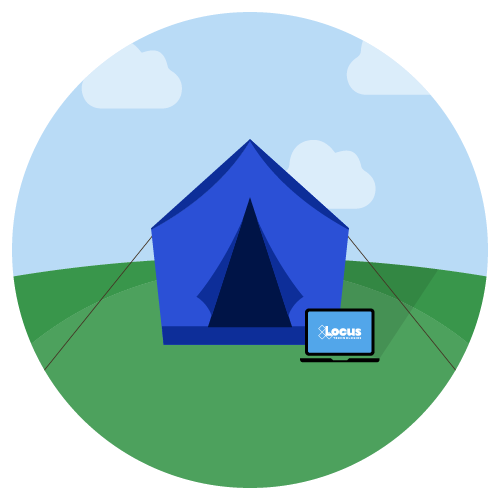 Off the Grid
Off the GridAt one time, the simple columns and rows in Excel seemed to provide a sufficient solution to prepare your REMP sampling data for reports. However, when you need to transfer data between systems, or create more sophisticated reports, those grids begin to feel like prison bars. Maybe it’s time to go off the grid and deploy a more modern solution that can connect and work side by side with your existing tools.
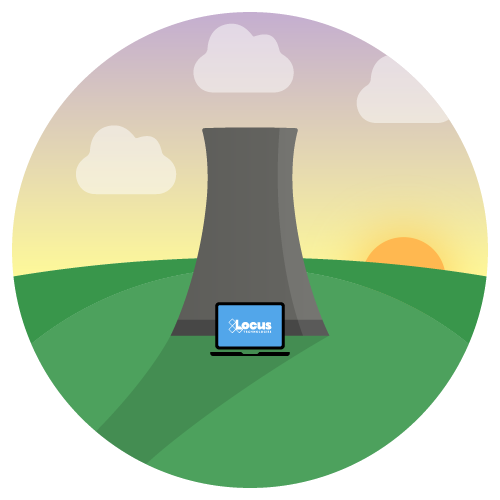 Sunsetting (Decommissioning)
Sunsetting (Decommissioning)Closing a power plant is a long and involved process that many attendees were in the process of dealing with or will be in the near future. This operational change can be the motivation to rethink the way radiological data is sampled and managed. Some software packages can be too big for the job. Locus offers a modular approach where you only pay for what you need. Choosing which system tools are relevant to the type of data sampling and resources available can minimize implementation cost and increase productivity.
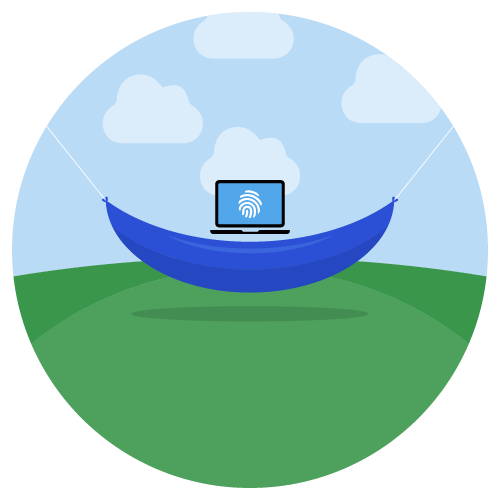 Serene Security
Serene SecurityMany people we spoke with at REEW had serious security concerns. Locus takes those concerns seriously. We are SOC 1 and SOC 2 certified and have migrated our software to Amazon Web Services. All customer data is stored with AWS, one of the most advanced and secure cloud-hosting providers on the planet. Locus provides the ability to control user permissions, customizing access based on job duties. This provides a more granular approach to data security.
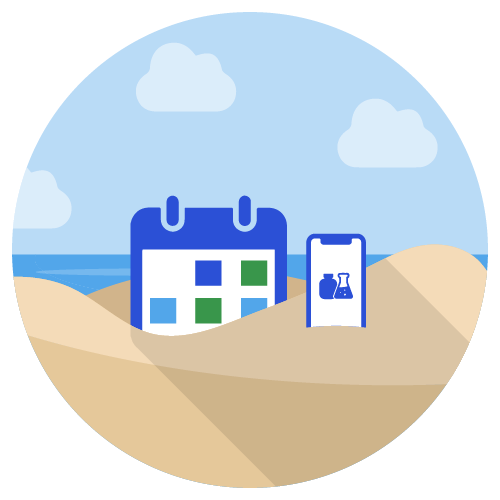 Making Plans
Making PlansUsing a sample planning application organizes sample events and allows for scheduling weeks, months, or years in advance. Many were interested in this powerful tool that is flexible enough to adapt when a reactor changes modes, allowing for one-time, ad-hoc samples. Mobile applications that integrate with planned samples and events minimize setup, ease data collection, speed up loading field data, and can expedite samples to the lab more efficiently.
Your feedback has helped Locus build a solution that makes it easy to manage all your facility’s data for RETS/REMP, helping you meet your NRC reporting requirements. We enjoyed speaking with everyone at REEW and we look forward to seeing you again next year!
Learn more about Locus for Nuclear.
About the author—Danny Moore, Locus Technologies

Mr. Moore has spent the last decade designing and marketing for enterprise SaaS systems. In his career at Locus, he leads a team of marketing professionals in branding, content creation, social media engagement, and email outreach. Mr. Moore enjoys attending conferences as a Locus brand ambassador and sharing any feedback gained to improve product development.
About the author—Bill Donaldson, Locus Technologies

Mr. Donaldson has 5 years experience in SaaS systems, performing Product Management and QA/QC of Locus Mobile iOS application and Locus’ Environmental Information Management system (EIM). While completing his B.S., Mr. Donaldson held several paid internships, where he configured a Relational GeoDatabase and a Database Management System (DBMS), for biological data entry.
Locus handles all the EPA required environmental data collected at your refinery giving you a simple solution for all your data management and reporting needs.
US EPA fenceline monitoring data collection officially begins on January 30, 2018. We have put together an infographic to show you some of the ways Locus EIM can help you streamline, consolidate, and take control of all your important environmental information using maps, data reports, formatted outputs, charts, and more!
Click image for larger version
Locus Technologies » Air Quality
299 Fairchild Drive
Mountain View, CA 94043
P: +1 (650) 960-1640
F: +1 (415) 360-5889
Locus Technologies provides cloud-based environmental software and mobile solutions for EHS, sustainability management, GHG reporting, water quality management, risk management, and analytical, geologic, and ecologic environmental data management.
